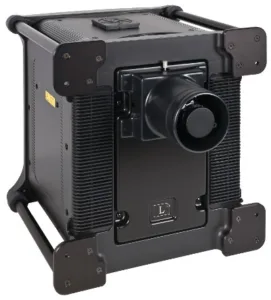One of the best performing projectors in the simulation market is the ProSim projector (also known as the Zoro projector) manufactured by Rockwell Collins. According to officials at I/ITSEC 2015, the company has now sold over 2000 of these projectors. But it is growing a little old and there was no news of an upgrade coming at I/ITSEC 2015.
The ProSim projector was developed by Seos over a decade ago and Rockwell Collins later purchased the company. Among other platforms, it is used in the Rockwell Collins Griffin Dome simulator. This is a nearly full spherical fast-jet simulator that uses 25 of the ProSim projectors with a single eyepoint in the center of the dome. The trainer needs to slide in on a sled to the central position. I actually had a chance to experience this simulator on a trip to Rockwell Collins UK facility a couple of years ago and I was quite impressed.
So what is good about the ProSim projector? In a word, contrast. It uses a four-panel LCOS architecture to achieve extremely low black levels (around 10 micro-nits). The projector consists of a standard 3-chip LCOS engine followed by a fourth panel that adds additional modulation on a pixel-by-pixel basis. This is a high dynamic range projector with about a million to one contrast ratio.
Really low black levels are particularly important in blended projector simulators where dim or night simulations are run. Whenever you blend projectors, there is an overlap region. But where the projectors overlap, you have twice as much light which raises the black level. An even and consistent black level is needed for uniformity so you have two choices. One is to place black plates near the projection lens to optical block light in the overlap region. Alternatively, you can electronically adjust the black level higher in the non-overlapped areas to make a uniform, but higher black level state.
In complex applications like the Griffin Dome, there are some areas where four projectors overlap. Constructing plates to reduce light is just too complex so they have to use electronic methods. Now, the extremely low black level of the projectors makes a difference because you start at such a low level that increasing the floor 3 or 4 times is still a very black image.
So why does the ProSim projector need a refresh? For one, the resolution is no longer state-of-the-art at SXGA (1280×1024). It is lamp-based and new solid-state options are maturing quickly, plus, it is a bit dim at 500 lumens. And, the LCOS panels, apparently made by Sony, may not always be available, so Rockwell Collins should be thinking about an upgrade. To their credit, they are, but there were no details they could discuss at I/ITSEC 2015.

